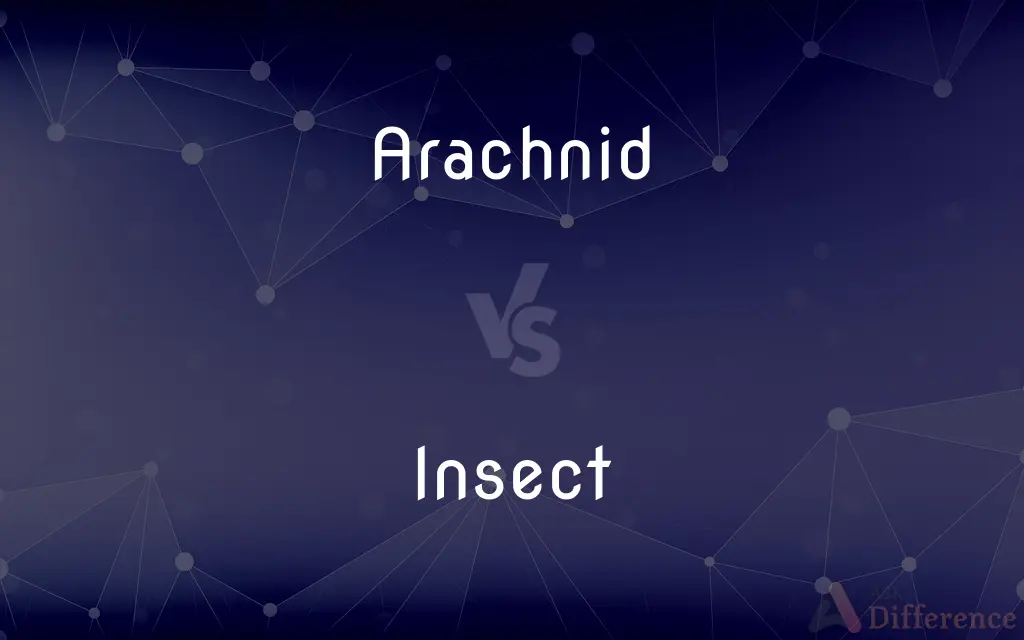Arachnid vs. Insect — What's the Difference?
By Urooj Arif & Fiza Rafique — Updated on April 2, 2024
Arachnids are primarily eight-legged creatures like spiders, while insects have six legs and include flies and beetles.

Difference Between Arachnid and Insect
Table of Contents
ADVERTISEMENT
Key Differences
Arachnids are a class of joint-legged invertebrates within the arthropod group, characterized by having eight legs. They include spiders, scorpions, ticks, and mites. Arachnids are known for their lack of antennae and wings, which sets them apart from insects. Whereas insects belong to the class Insecta and are distinguished by having six legs, a body divided into three main parts (head, thorax, abdomen), and often possess wings and antennae. This fundamental difference in body structure and number of legs is the most noticeable distinction between the two groups.
Arachnids usually have two main body segments: the cephalothorax and the abdomen, which are joined by a small, narrow pedicel. This body structure supports their predatory lifestyle, with many arachnids being skilled hunters. On the other hand, insects have a more varied diet and ecological roles, facilitated by their three-part body structure, allowing for a wide range of adaptations, including pollination and detritivory.
Reproduction in arachnids often involves complex mating rituals and in some cases, like spiders, the use of silk. In contrast, insects employ a variety of reproductive strategies, including laying eggs, live birth in some species, and complex social structures in others, such as bees and ants, that aid in the care of offspring.
Arachnids are primarily solitary creatures, with the exception of some species of mites and ticks. Their solitary nature is reflected in their hunting methods, territory establishment, and mating behaviors. Conversely, many insects exhibit highly social behaviors, forming complex colonies with division of labor, such as bees, ants, and termites, showcasing a stark contrast in social structure.
Sensory organs in arachnids and insects are adapted to their lifestyles. Arachnids have specialized organs like chelicerae and pedipalps for detecting and capturing prey, whereas insects have compound eyes and antennae that are highly sensitive to chemical signals and movements, aiding in navigation, finding food, and communication.
ADVERTISEMENT
Comparison Chart
Legs
8
6
Body Segments
2 main segments (cephalothorax and abdomen)
3 main parts (head, thorax, abdomen)
Antennae
Absent
Present
Wings
Absent
Often present
Lifestyle
Predominantly solitary
Varies, from solitary to highly social
Compare with Definitions
Arachnid
Primarily solitary.
Most arachnids, including spiders, lead solitary lives, interacting mainly during mating.
Insect
Possession of antennae and often wings.
Butterflies are known for their colorful wings and antennae used for sensing.
Arachnid
Specialized predators.
Scorpions use their venomous stingers to immobilize prey, showcasing their predatory nature.
Insect
Highly varied lifestyles.
Ants live in complex social colonies, unlike many solitary insects.
Arachnid
Two main body segments.
Scorpions, with their distinct cephalothorax and abdomen, are easily recognized arachnids.
Insect
Three main body parts.
Flies have a clear division of head, thorax, and abdomen.
Arachnid
Lack of antennae and wings.
Unlike insects, ticks, as arachnids, do not have antennae or wings.
Insect
Diverse roles in ecosystems.
Bees play a crucial role in pollination, affecting many plant species.
Arachnid
Eight-legged creatures.
Spiders use their eight legs to expertly navigate and build webs.
Insect
Insects or Insecta (from Latin insectum) are pancrustacean hexapod invertebrates and the largest group within the arthropod phylum. Insects have a chitinous exoskeleton, a three-part body (head, thorax and abdomen), three pairs of jointed legs, compound eyes and one pair of antennae.
Arachnid
Arachnida () is a class of joint-legged invertebrate animals (arthropods), in the subphylum Chelicerata. Arachnida includes orders containing spiders (the largest order), scorpions, ticks, mites, harvestmen, and solifuges.
Insect
A small arthropod animal that has six legs and generally one or two pairs of wings
Insect pests
Arachnid
Any of various arthropods of the class Arachnida, such as spiders, scorpions, mites, and ticks, characterized by four pairs of segmented legs and a body that is divided into two regions, the cephalothorax and the abdomen.
Insect
Any of various other small, chiefly arthropod animals, such as spiders, centipedes, or ticks, usually having many legs. Not in scientific use.
Arachnid
Any of the eight-legged creatures, including spiders, mites, and scorpions, of the class Arachnida.
Insect
An insignificant or contemptible person.
Arachnid
An arachnidan.
Insect
An arthropod (in the Insecta class) characterized by six legs, up to four wings, and a chitinous exoskeleton.
Our shed has several insect infestions, including ants, yellowjackets, and wasps.
Arachnid
Air-breathing arthropods characterized by simple eyes and four pairs of legs
Insect
(colloquial) Any small arthropod similar to an insect, including spiders, centipedes, millipedes, etc.
The swamp is swarming with every sort of insect.
Insect
(derogatory) A contemptible or powerless person.
The manager’s assistant was the worst sort of insect.
Insect
One of the Insecta; esp., one of the Hexapoda. See Insecta.
Insect
Any air-breathing arthropod, as a spider or scorpion.
Insect
Any small crustacean. In a wider sense, the word is often loosely applied to various small invertebrates.
Insect
Fig.: Any small, trivial, or contemptible person or thing.
Insect
Of or pertaining to an insect or insects.
Insect
Like an insect; small; mean; ephemeral.
Insect
Small air-breathing arthropod
Insect
A person who has a nasty or unethical character undeserving of respect
Insect
Six-legged creatures.
Bees use their six legs for walking and gathering pollen.
Common Curiosities
What defines an arachnid?
Arachnids are characterized by having eight legs, two main body segments, and no antennae or wings.
Can insects fly?
Many insects have wings and can fly, such as flies and butterflies.
Are arachnids social creatures?
Most arachnids are solitary, with few exceptions.
Do all arachnids have venom?
Many arachnids, like spiders and scorpions, have venom, but not all.
How do arachnids reproduce?
Arachnids have various reproduction methods, often involving complex mating rituals.
What sensory organs are unique to arachnids?
Arachnids have specialized organs like chelicerae and pedipalps for detecting prey.
What adaptations do arachnids have for hunting?
Arachnids have venomous bites or stings and specialized limbs for capturing prey.
What roles do insects play in the ecosystem?
Insects have diverse roles including pollination, decomposition, and serving as food for other species.
Do any insects exhibit social behavior?
Yes, many insects, like bees and ants, have complex social structures.
How many legs do insects have?
Insects have six legs.
What is the difference in body segments between arachnids and insects?
Arachnids have two main body segments, while insects have three.
How do insects communicate?
Insects communicate through chemical signals, sounds, and visual cues.
Can arachnids be found in diverse environments?
Yes, arachnids inhabit a wide range of environments, from deserts to forests.
Are all insects beneficial to humans?
While many insects are beneficial, like bees for pollination, others can be pests.
How do arachnids and insects differ in their approach to feeding?
Arachnids are primarily predators, while insects have a wide range of feeding habits including herbivory and detritivory.
Share Your Discovery

Previous Comparison
Witch vs. Mage
Next Comparison
Brighten vs. LightenAuthor Spotlight
Written by
Urooj ArifUrooj is a skilled content writer at Ask Difference, known for her exceptional ability to simplify complex topics into engaging and informative content. With a passion for research and a flair for clear, concise writing, she consistently delivers articles that resonate with our diverse audience.
Co-written by
Fiza RafiqueFiza Rafique is a skilled content writer at AskDifference.com, where she meticulously refines and enhances written pieces. Drawing from her vast editorial expertise, Fiza ensures clarity, accuracy, and precision in every article. Passionate about language, she continually seeks to elevate the quality of content for readers worldwide.














































